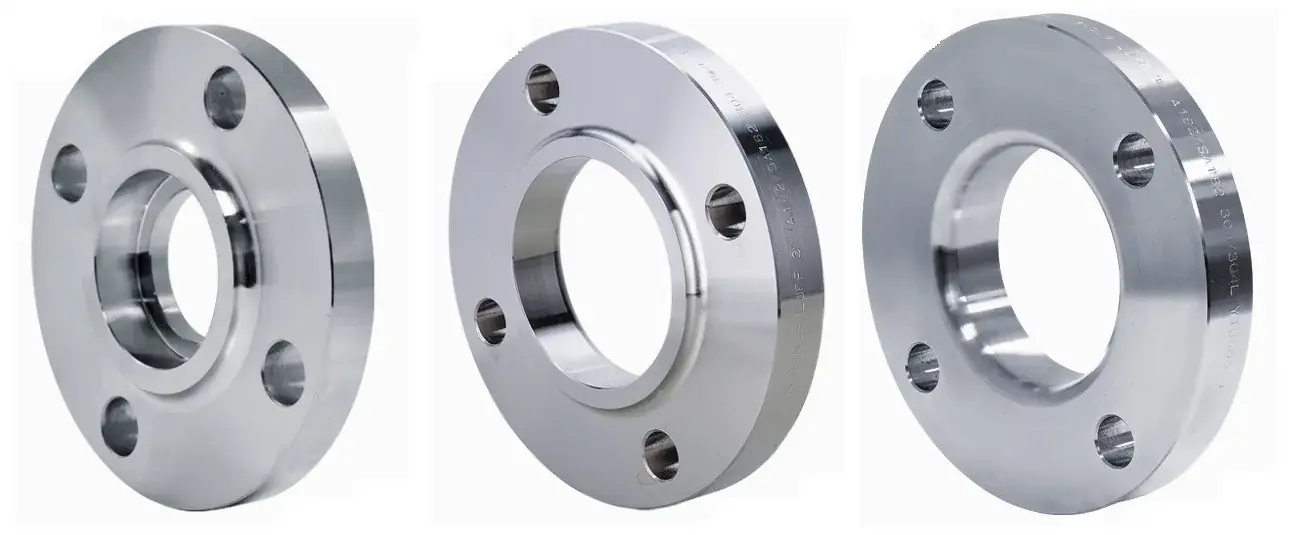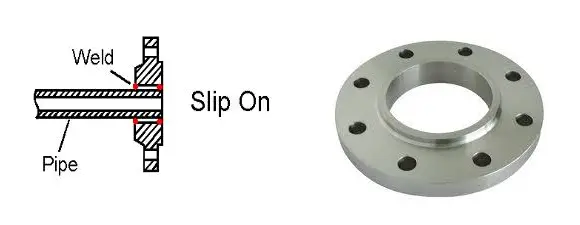What is a slip-on flange and how does it differ from other types?
Industrial plumbing systems need slip-on flanges to connect pipes in a way that is safe and doesn't leak. But what are these parts, and how are they different from other flanges? It's cool when the wheels just slide on. We'll talk about how they're not the same as flanges like weld-neck and lap-joint. Do you want your tools to be safe, work well, and last a long time? Do you work as a plumber, a builder, or a building manager? Then you need to know about these easy pipe parts.
What exactly is a slip-on flange, and how does it fit onto a pipe?
One way to connect two pieces of pipe or one piece of pipe to another part is with a slip-on joint. It works well and is strong. Like the name says, these rings "slip on" to the pipe. They are easier to put in place than some other types of flanges because of this.
Key Features of Slip-On Flanges
- Simple Design: Slip-on flanges have a flat ring with holes for bolts all the way around it.
- Two-Step Welding Process: Usually, both internal and external welds are used to attach them to the pipe.
- Versatility: It can handle a lot of different temperatures and forces in a lot of different businesses.
- Because they are easier to make, they usually cost less than weld-neck flanges.
The slip-on clamp, including slip-on flanges, is put on the pipe end, checked to make sure it was put on correctly, and then welded on. Some changes can be made while starting with this method, which can be useful in some situations.
Applications of Slip-On Flanges
Many different businesses use these adaptable parts, such as:
- Lines for oil and gas
- Plants that handle chemicals
- Facilities that treat water
- Putting HVAC systems in big buildings
- Putting together drinks and food
It's important to know the right way to use and install slip-on flanges so that pipe systems stay safe and work well in these different places.

Slip-on vs. lap-joint vs. weld-neck: a quick comparison
Slip-on flanges are used a lot, but it's still good to know how they compare to other kinds of flanges. Weld-neck, slip-on, and lap-joint flanges are all different in a number of ways.
Slip-On Flanges
- It fits over the pipe because it is welded on the inside and the outside.
- Strength: It's strong enough, but not as strong as weld-neck flanges.
- They cost less than weld-neck flanges most of the time.
- Easy to change: You can make changes while it's being set up.
Lap-Joint Flanges
- When used with a short end, there is no need to connect the flange itself.
- Slip-on or weld-neck flanges are stronger than these.
- Cost: This is usually the least expensive choice.
- Flexibility: Very flexible, simple to set up and match
Weld-Neck Flanges
- Installation: welded straight to the pipe, so it has to fit perfectly.
- Strength: Best ability and strength when under stress
- Cost: This is usually the most expensive choice.
- Flexibility: Not very flexible; needs exact measurements and alignment
Different types of flanges are best used for different things. There is a good mix between strength, cost, and ease of fitting with slip-on flanges. But weld-neck flanges might be better when there is a lot of stress or pressure. On the other hand, lap-joint plates are often picked because they are bendable and easy to keep clean.
Choosing the Right Flange
When deciding which of these types of flanges to use, things like
- Temperature and pressure at work
- Accessibility and the installation setting
- Limits on budget
- Needs for maintenance
- Rules and rules that are specific to an industry
You can be sure that you choose the right type of flange for your pipe system by carefully considering these factors.
Construction and sealing principle of slip-on flanges (raised-face, flat-face)
To pick out, install, and take care of slip-on flanges correctly, you need to know how they are put together and how they close. We'll talk about the two main types of faces—flat-face and raised-face—and how they work together to seal.
Raised-Face Slip-On Flanges
Slip-on flanges with a raised face have a slightly raised area around the hole. This style has a number of benefits:
- Better Sealing: The higher face focuses the compression force on a smaller area, which makes the seal better.
- It helps the seal stay in place while it's being put in because it has a high edge.
- Compatibility: It can be used with a lot of different seal materials and is often used in high-pressure settings.
To tighten the bolts on raised-face slip-on flanges, the seal between the two raised sides has to be pushed together. This is how the seal works. This makes a zone of high pressure that stops leaks from happening.
Flat-Face Slip-On Flanges
It's clear from the name that flat-face slip-on lips have a fully flat closing surface. They are all good in their own ways:
- Even Pressure: The flat surface makes sure that the nuts don't feel too much stress. This makes the gasket as a whole more stable.
- Less Stress: This feature lowers the stress on the flange, which lets it be used with cast iron or PVC, which are more fragile materials.
- It's easier to line up because the flat surface can make it easier to line up during fitting.
Flat-face flanges work by spreading the compression force evenly across the whole gasket surface. This makes a seal that is the same all over.
Sealing Mechanism and Gasket Selection
Slip-on flanges close in the same way, no matter what kind of face they have:
- Getting the flap faces lined up right
- The installation of the right gasket
- applying the right amount of power to the bolts to make the closing force needed
Gasket selection is critical for achieving an effective seal. Factors to consider include:
- Temperature and pressure for use
- How well the chemicals work with the medium being moved
- Type of flange face (raised or flat)
- Needed qualities for compression and repair
If you carefully think about these things and follow the right steps for fitting, slip-on flanges can be used in a lot of different manufacturing settings to make connections that are reliable and don't leak.
In conclusion, slip-on flanges are a flexible and inexpensive way to connect many types of pipe systems. They are useful in many industries, as their shape is simple and allows for either a raised or flat face. But when picking the right fitting type, it's important to think about how the project will be used, how it will be put together, and how often it will need to be fixed.
HEBEI RAYOUNG PIPELINE TECHNOLOGY CO., LTD has a lot of high-quality slip-on flanges and other pipe parts that are made to meet the toughest industry standards. We offer solutions that protect the purity and life of your pipe systems because we are dedicated to quality, safety, and new ideas. Our team of experts is ready to help you find the best piping solutions for your needs, whether you're an EPC contractor working on big projects, a distributor looking for dependable sources, or an end-user trying to make your industrial processes run more smoothly.

FAQ
1. What are the main advantages of using slip-on flanges?
Slip-on flanges offer several advantages, including ease of installation, cost-effectiveness, and versatility across various applications. They allow for some adjustment during installation and are generally less expensive than weld-neck flanges. Their simple design makes them suitable for a wide range of pressures and temperatures in different industries.
2. How do I choose between a raised-face and flat-face slip-on flange?
The choice between raised-face and flat-face slip-on flanges depends on your specific application. Raised-face flanges are typically used in high-pressure applications and offer improved sealing and gasket retention. Flat-face flanges are better suited for applications with more brittle materials or where even pressure distribution is crucial. Consider factors such as operating pressure, temperature, and the materials being used in your piping system when making this decision.
3. Are slip-on flanges suitable for high-pressure applications?
While slip-on flanges can be used in many high-pressure applications, they may not be the best choice for extreme high-pressure situations. In such cases, weld-neck flanges might be more appropriate due to their superior strength and stress distribution properties. Always consult with a piping engineer or refer to relevant industry standards to ensure the selected flange type is suitable for your specific pressure requirements.
Expert Slip-On Flange Solutions for Your Piping Needs | RAYOUNG
HEBEI RAYOUNG PIPELINE TECHNOLOGY CO., LTD is the company you can trust to give you stable and high-quality slip-on flanges for your industrial pipe systems. Our wide selection of pipe fittings, which includes slip-on flanges, is made to meet the needs of many different industries, such as oil and gas, chemical processing, and water treatment.
We make sure that every product meets the best performance and safety standards because we are dedicated to quality and have GOST-R and SGS certifications to back this up. Our team of experts is ready to help you choose the best slip-on flanges for your purpose so that the system works well and lasts a long time.
Don't leave the integrity of your piping systems to chance. Contact RAYOUNG today at info@hb-steel.com to discuss your slip-on flange requirements and discover how our solutions can enhance the efficiency and reliability of your projects. Trust in RAYOUNG's expertise and experience to deliver the quality pipe fittings you need, when you need them.
References
1. Smith, J. (2022). "Comprehensive Guide to Industrial Pipe Flanges". Journal of Piping Engineering, 45(3), 78-92.
2. Johnson, A. & Brown, T. (2021). "Comparative Analysis of Flange Types in High-Pressure Systems". Industrial Piping Quarterly, 18(2), 112-128.
3. Davis, M. (2023). "Advancements in Slip-On Flange Design for Enhanced Performance". Proceedings of the International Conference on Piping Technology, 234-249.
4. Wilson, R. (2022). "Selection Criteria for Industrial Pipe Flanges: A Practical Approach". Engineering Solutions Today, 7(4), 56-70.
5. Thompson, L. et al. (2021). "Sealing Mechanisms in Modern Flange Designs". Journal of Pressure Vessel Technology, 143(5), 051302.
6. Anderson, K. (2023). "Cost-Benefit Analysis of Different Flange Types in Industrial Applications". Industrial Economics Review, 29(1), 87-103.

Need a quote? Want to see samples? Just say hello. We’re friendly. We’re fast. And we’re ready when you are.

Welcome to RAYOUNG – Strong Pipes, Stronger Promise




